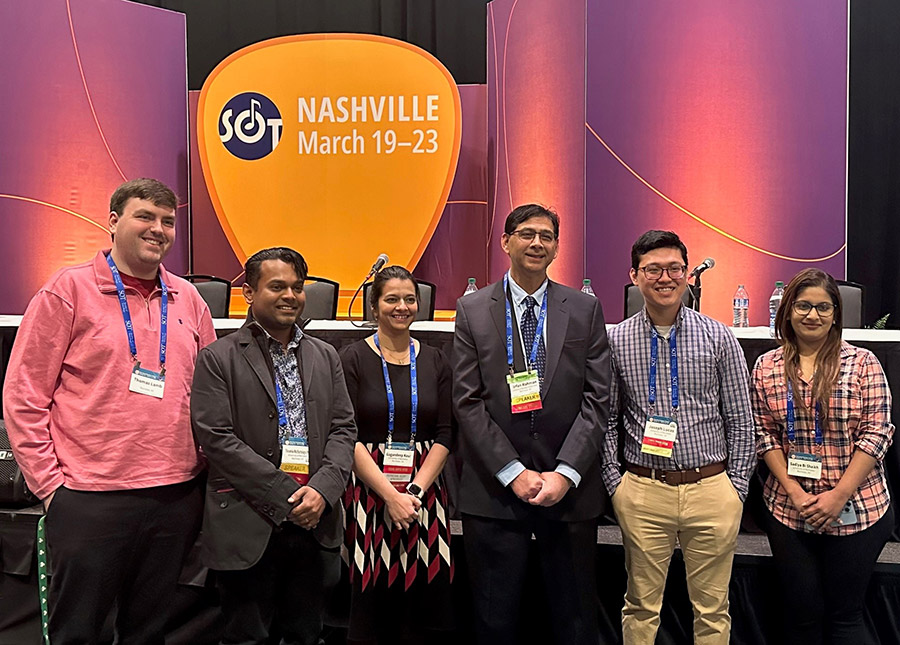August 10, 2023

In December 1984, disaster struck the city of Bhopal, India. A significant gas leak from a pesticide plant — now considered the world’s worst industrial disaster — exposed over half a million people to the highly toxic gas methyl isocyanate, immediately killing over 2,000 residents and causing lifelong injury and disease among many others.
A teenager at the time, Irfan Rahman, Ph.D., survived the disaster and was stunned by its effects. He has since dedicated his career to understanding how inhaled toxicants affect health.
Rahman is now a professor in the Department of Environmental Medicine at the University of Rochester Medical Center (URMC), where his research lab studies the cellular and molecular mechanisms involved in the development of chronic inflammatory lung diseases. With consistent NIH funding since 2007, he has studied how environmental tobacco smoke induces inflammation by disrupting biological processes known as circadian rhythms.
E-Cigarettes and Circadian Clocks
Cells in nearly every human tissue and organ contain proteins that govern circadian rhythms. In essence, these molecules together act as a microscopic clock timed to waxing and waning sunlight.
“When sunlight enters your eyes in the morning, it sends a signal to the pineal gland in your brain that sets off a chain reaction of hormone production, waking your body up and affecting your appetite, body temperature, blood pressure, and more,” Rahman explained. “As darkness sets in, your body winds down, preparing for sleep.”
Rahman studies how environmental exposures affect molecular clock proteins in the lungs.
“The molecular clock’s purpose is to prepare your body for expected changes in the environment, like the times for activity, times for sleep, and times to eat,” Rahman said. “However, environmental exposures, including tobacco smoke and vaping, can disrupt the production of clock molecules, leading not only to changes in sleep cycles but also to lung injury or respiratory disease.”

For example, in a study on the effects of trendy e-cigarette and tobacco products on lung health, Rahman and team found that exposure to either waterpipe smoke or e-cigarette vapor altered expression of molecular clock proteins in mouse lungs. Those changes could in turn affect lung function, the authors suggested.
Jet lag, night-shift work, and blue light from electronic devices can also affect the molecular clock. Smoking or vaping can potentially exacerbate the impacts of those factors.
Finding a Fibrosis Treatment
In a recent study, Rahman and team discovered how a specific clock molecule, called REV-ERBα, contributes to pulmonary fibrosis — a disease that occurs when lung tissue becomes damaged and scarred, causing difficulty breathing. Levels of REV-ERBα typically peak at midday and drop at night.
The researchers exposed mice to bleomycin, a chemical that decreases the abundance of REV-ERBα, and to influenza A virus to cause injury in the lungs.
“We found that a lack of REV-ERBα contributes to lung scarring in mice by increasing production of collagen, a major component of connective tissue, and lysyl oxidase, which stabilizes connective tissue and makes it more rigid,” Rahman explained. “When we induced lung injury at night — when even lower levels of REV-ERBα are present — the mice had more extensive lung damage compared to mice injured in the morning.”
According to Rahman, REV-ERBα could be a potential target for therapeutic drugs. Treatment that activates REV-ERBα expression could also prevent lysyl oxidase and collagen production, leading to protection against fibrosis.
This potential treatment may also help people with other lung diseases, such as chronic obstructive pulmonary disease (COPD), and reduce the negative effects of smoking and vaping, Rahman said.
Impacts of Aging

Beyond affecting molecular clocks, smoking and vaping can accelerate the process of cellular senescence, when cells stop multiplying but have not yet died. Senescence can damage neighboring cells and lead to inflammation in the lungs.
“Cellular senescence is a hallmark of aging, so a 45-year-old who vapes might actually have the lung function of a 60-year-old,” Rahman said. “Premature aging can make individuals more susceptible to diseases like pulmonary fibrosis and COPD.”
Earlier in 2023, Rahman led a study exploring how removing senescent cells from the lungs could alleviate the symptoms of lung diseases.
The team exposed mice to cigarette smoke to induce cellular senescence in the lungs, and then treated them with a drug called ganciclovir, which can destroy senescent cells.
“By clearing the senescent cells, we found a decreased immune system response in the mice, as well as a decrease in swelling,” Rahman said.
According to Rahman, therapeutic drugs that specifically target senescent cells may be a promising treatment for diseases like COPD and emphysema.
Training the Next Generation

Over the years, Rahman has successfully mentored several graduate students and postdoctoral fellows. He considers the accomplishments of his trainees as testaments to the success of his career in pulmonary research.
“Support from NIEHS has been pivotal to my success in teaching,” Rahman said. “Many of my students have gone on to receive career awards from the institute.”
Rahman wants the next generation of scientists to dive deeper into the unanswered questions uncovered by his research.
“What other diseases are regulated by molecular clock molecules, and how does aging play a role?” Rahman asked. “Then, we can find the right treatments so people will not suffer from environmentally induced chronic diseases.”


